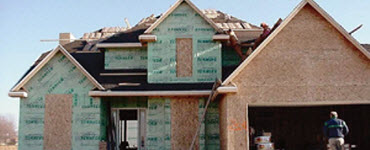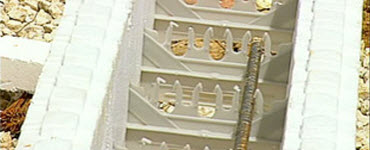Framing options
Advanced framing
This framing technique uses less wood and allows for more insulation.
In this video: See advanced framing going up in a home and learn how it keeps a home more energy efficient.
Aim for R-19 minimum
The most effective way to achieve this level is to use 2x6 studs to frame the sidewalls . The added two inches of depth allows for a 5-1/2-inches of insulation (approx. R-19), instead of the 3-1/2-inches (approx. R-13) available with conventional 2x4 studs.
Upgrading to 2x6 construction costs about $1 more per square foot - but the difference will quickly be paid back in energy savings.
Two-by-six construction also provides greater noise reduction, because the additional insulation does a better job of muffling sound.
If you choose to stick with 2x4 construction, your builder should use rigid foam insulation on the interior. This material offers an insulating value of up to R-6; adding this to the 3-1/2 inches of between-the-studs insulation will bring the total R-value of the wall to the recommended R-19.
Many builders in the Midwest will add an inch of rigid foam insulation between the stud wall and the exterior sheathing. This outer layer prevents heat loss through the wall, and brings the total insulation value to R-24 with a 2x6 stud wall.
Alternative framing materials
Wood framing isn't the only option for building your new home. Several alternative methods are becoming more prevalent across the Midwest.Unlike traditional wood construction, structural insulated panels use no wood studs in the construction process. These strong, super-insulated structural building components can be used for floors, walls and roof.
Steel-framed homes, discussed in more detail below, use steel studs for walls and roof trusses instead of traditional wood studs. Steel framing can be designed to meet or exceed energy efficiency standards. By using a 2x6 steel stud, the insulating value is R-36 - almost double the R-19 of traditional wood construction.
Steel framing
How it works
Steel homes use steel studs for walls and roof trusses instead of traditional wood studs. Steel framing contractors use computers to design the framing to meet with local building codes.If you have architect plans for a wood-framed house, they can create a computer-generated drawing for a steel home, along with a list of parts needed to replace the lumber.
The factory-engineered framing pieces - predrilled for plumbing and wiring - arrive at the building site numbered and color-coded. From there, it's like building a home with a giant Erector set!
Energy savings
Steel framing can be designed to meet or exceed energy efficiency standards. By using a 2x6 steel stud, the insulating value is R-36 - almost double the R-19 of traditional wood construction.In addition, by staying straight and true, the steel framing helps prevent cracks due to shrinking or warping, meaning fewer air leaks that waste energy.
Other benefits
Steel is also a good choice for the environment. Steel is 100 percent recyclable - most of the studs are created with recycled steel, and any construction leftovers are recycled instead of taken to the landfill.Steel framing was originally developed for use along the coastlines of the U.S., where hurricanes, earthquakes, humidity and insects wreak havoc on wood homes - but homeowners in the Midwest can enjoy the advantages as well. A steel-framed home can withstand winds up to 180 miles an hour, and is virtually termite-proof.
In addition, the strength of steel allows you to design your home with larger open spaces - the walls will remain straight and true. Any typical finishing material can be used indoors or out, including drywall, plaster, siding, brick or stucco.
Costs
Construction costs for a steel-framed home are typical about one to two percent more than wood framing,The cost of steel framing has been relatively constant over the last decade. While the price of traditional framing materials has been erratic and growing at a much faster rate than inflation, steel prices have been much more stable.
More from this category
Historic preservation
A preservation expert shares how to restore an older home economically and energy efficiently.
Energy efficient kitchen remodel
This kitchen remodel features a new window, energy-efficient lighting, new appliances and side-wall insulation.
Aging in place
Finding an energy-smart builder
An energy-smart builder will help you make the right choices for your family and lifestyle.
Insulated concrete forms
An insulated concrete form (ICF) system eliminates the cold drafts typical of wood-frame construction.
New home comfort issues
Talk to your utilities
Before you break ground on a new house, give your utility companies a call. They can help you avoid unnecessary expenses and construction delays.
Air quality and ventilation in new homes
New, energy-efficient homes need new solutions to circulate and ventilate the air inside the home.









